COBS News archive
The origins of dark comets
Is this comet doomed?
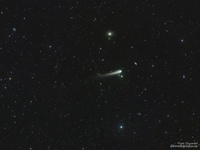
SOHO reaches 5000 comets
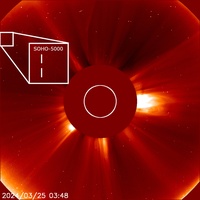
On March 25, 2024, a citizen scientist in the Czech Republic spotted a comet in an image from the Solar and Heliospheric Observatory (SOHO) spacecraft, which has now been confirmed to be the 5,000th comet discovered using SOHO data. SOHO has achieved this milestone over 28 years in space, even though it was never designed to be a comet hunter.
Records of cometary dust hitting the asteroid Ryugu
How to see newly discovered Comet Nishimura
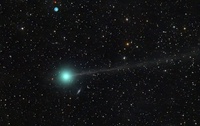
The new comet to look for with the naked eye.
A new comet is visible in the predawn skies as it passes close to Earth on its journey around the Sun. Comet Nishimura is green in color with a long, white tail. It will make its closest pass by Earth on Sept. 12, 2023, and then will carry on toward the Sun.
Asteroid's comet-like tail Is not made of dust, solar observatories reveal
We have known for a while that asteroid 3200 Phaethon acts like a comet. It brightens and forms a tail when it's near the Sun, and it is the source of the annual Geminid meteor shower, even though comets are responsible for most meteor showers. Scientists had blamed Phaethon's comet-like behavior on dust escaping from the asteroid as it's scorched by the Sun. However, a new study using two NASA solar observatories reveals that Phaethon's tail is not dusty at all but is actually made of sodium gas.
New Moravian Instruments Camera type keys
ICQ confirmed new abbreviation keys
Comet impacts formed continents when Solar System entered arms of Milky Way
New Comets C/2022 L1
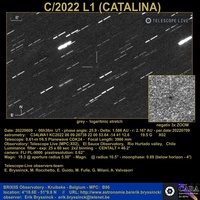
CBET 5134 & MPEC 2022-L97, issued on 2022, June 13, announce that an apparently asteroidal object discovered on June 4 with the 0.68-m Schmidt reflector of the Catalina Sky Survey has been found to show cometary appearance by CCD astrometrists elsewhere after the Minor Planet Center posted it to the PCCP webpage on the basis of a comet-like orbit. The new comet has been designated C/2022 L1 (Catalina).
New Comets C/2022 J1
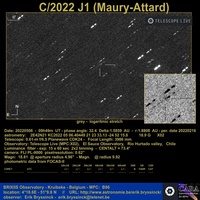
Near-sun comet roasted to death
Astronomers using a fleet of world leading telescopes on the ground and in space have captured images of a periodic rocky near-Sun comet breaking apart. This is the first time such a comet has been caught in the act of disintegrating and could help explain the scarcity of such periodic near-Sun comets.
Comet Interceptor approved for construction
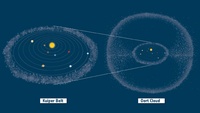
ESA’s Comet Interceptor mission to visit a pristine comet or other interstellar object just starting its journey into the inner Solar System has been ‘adopted’ this week; the study phase is complete and, following selection of the spacecraft prime contractor, work will soon begin to build the mission.
New Comet C/2022 F2 (NEOWISE)
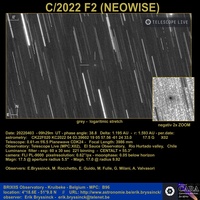
CBET 5113 & MPEC 2022-G83, issued on 2022, April 06, announce the discovery of a comet (magnitude ~17) in infrared exposures obtained during Mar. 30-Apr. 1 UT with the Near-Earth Object Wide-field Infrared Survey Explorer (or NEOWISE; formerly the WISE earth-orbiting satellite). The new comet has been designated C/2022 F2 (NEOWISE).
New Comet C/2022 F1 (ATLAS)
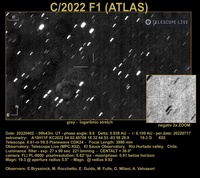
CBET 5112 & MPEC 2022-G82, issued on 2022, April 06, announce the discovery of a comet (magnitude ~18.5) on CCD images taken on Mar. 30.3 UT with a 0.5-m f/2 Wright-Schmidt reflector at Rio Hurtado, Chile, in the course of the "Asteroid Terrestrial-Impact Last Alert System" (ATLAS) search program. The new comet has been designated C/2022 F1 (ATLAS).
Hubble Confirms Largest Comet Nucleus Ever Seen

NASA's Hubble Space Telescope has determined the size of the largest icy comet nucleus ever seen by astronomers. The estimated diameter is approximately 80 miles across, making it larger than the state of Rhode Island. The nucleus is about 50 times larger than found at the heart of most known comets. Its mass is estimated to be a staggering 500 trillion tons, a hundred thousand times greater than the mass of a typical comet found much closer to the Sun.
New Comet C/2022 E3 (ZTF) may reach mag. +6 in Feb. 2023
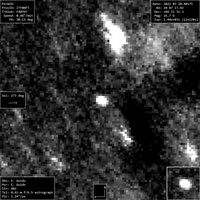
CBET 5111 & MPEC 2022-F13, issued on 2022, March 21, announce the discovery of an apparently asteroidal object (magnitude ~17) discovered on CCD images taken on Mar. 2 UT with a 1.2-m f/2.4 Schmidt telescope at Palomar in the course of the "Zwicky Transient Facility" (ZTF) survey (MPC code I41). Subsequently, it has been found to show cometary appearance by CCD astrometrists elsewhere. The new comet has been designated C/2022 E3 (ZTF).
New Comet C/2022 E2 (ATLAS)
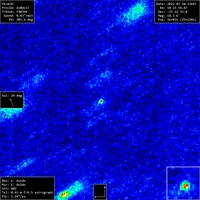
CBET 5109 & MPEC 2022-E227, issued on 2022, March 15, announce the discovery of an apparently asteroidal object (magnitude ~19) discovered on CCD images taken on Mar. 7 UT with a 0.5-m f/2 Schmidt reflector at Rio Hurtado, Chile, in the course of the "Asteroid Terrestrial-Impact Last Alert System" (ATLAS) search program. Subsequently, it has been found to show cometary appearance by CCD astrometrists elsewhere after it was posted on the Minor Planet Center's PCCP webpage. The new comet has been designated C/2022 E2 (ATLAS).
Comet 67P’s abundant oxygen more of an illusion, new study suggests
When the European Space Agency's Rosetta spacecraft discovered abundant molecular oxygen bursting from comet 67P/Churyumov-Gerasimenko (67P) in 2015, it puzzled scientists. They had never seen a comet emit oxygen, let alone in such abundance. But most alarming were the deeper implications: that researchers had to account for so much oxygen, which meant reconsidering everything they thought they already knew about the chemistry of the early solar system and how it formed.